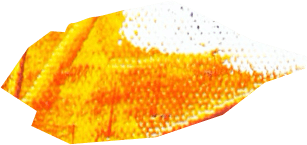For Rembrandt, his house was very important. It was not only where he lived, but also where he worked. It all came together here. The house and its inhabitants appear regularly in his work. But what about contemporary artists? What role does this house, and the feeling of home, play in their art? A selection of contemporary artists reflects on this theme and share their unique “feeling of home.”
THUIS
An exhibition about the feeling of home in contemporary art
What does ‘home’ mean? For some, it is an interior that suits you, for others a memory of the past. Or it is simply a safe place that is all yours. In the exhibition THUIS. The feeling of home in contemporary art, thirteen contemporary artists reflect on the sense of home – from symbols of home to the loss of a house. On view from 26 September 2025 to 4 January 2026 at Rembrandt’s home.
With artworks by Sadik Kwaish Alfraji, Arash Fakhim, Foundland Collective, Arjan van Helmond, Gvantsa Jgushia, Polina Medvedeva, Neda Mirhosseini, Olphaert den Otter, Satijn Panyigay, Pris Roos, Maria Roosen, Tian Teng, Pink de Thierry and Rembrandt.
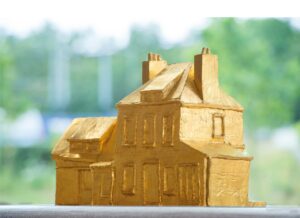
Maria Roosen, Droomhuis, 2002. Ceramic and gold foil, 48 x 32 cm. Collection AkzoNobel Art Foundation
At home with Rembrandt
For Rembrandt, everything came together in his house. It was the place where he lived, educated his students, received his clients, and created his masterpieces. Where he experienced joy and sorrow. A visit to the Rembrandt House Museum means stepping into Rembrandt’s shoes and into his home. The feeling of home is also a recurrent topic in his work, as are the people Rembrandt shared his house with. The exhibition THUIS. The sense of home in contemporary art shows several prints by Rembrandt: from a quick sketch of his sick wife Saskia in bed to narrative etchings in which ‘home’ means that you are always welcomed with open arms, or perhaps not.
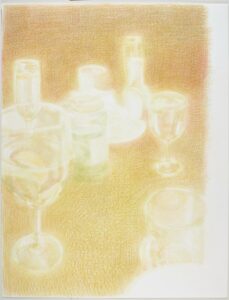
Neda Mirhosseini, Lunch at Fatemeh’s, 2024. Coulored pencil on paper. Museum Rembrandthuis, Amsterdam
Our current sense of home
What role does the house, and the sense of home, play in contemporary art? The feeling of home is a universal experience, relatable for everyone – whether you come from Amsterdam, Baghdad or Shanghai. It refers to a place where you can rest, love, play, be together and, above all, be yourself. In current times everyone also comes into contact, directly or indirectly, with the search for a new home. Never in history has there been so much global migration, whether voluntary or forced. And having (or keeping) a home is not a given for everyone.
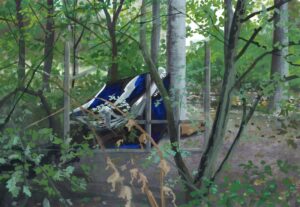
Olphaert den Otter, Uit de Postcodeserie 3084 AA #4, 2019. Egg-tempera on paper, 18 x 26 cm. Courtesy of the artist
Thirteen contemporary artists
In the exhibition THUIS. The feeling of home in contemporary art, thirteen contemporary artists reflect on the feeling of home – from symbols of home, the search for a new homeland and the house as an extension of your identity, to displacement and the loss of a home. The participating artists all work in the Netherlands, but many also have roots in other parts of the world: Sadik Kwaish Alfraji, Arash Fakhim, Foundland Collective, Arjan van Helmond, Gvantsa Jgushia, Polina Medvedeva, Neda Mirhosseini, Olphaert den Otter, Satijn Panyigay, Pris Roos, Maria Roosen, Tian Teng and Pink de Thierry.
Pris Roos builds a new ‘home’ in the exhibition
Artist Pris Roos will be working live in the exhibition space for the duration of the exhibition. Commissioned by the Rembrandt House Museum, she will spend two days a week building a new home using recycled cardboard and pastel chalk. In doing so, she continues her award-winning oeuvre of cardboard interiors, in which the personal story of one individual is brought to life each time. This installation is based on conversations that Roos regularly has with people – friends, acquaintances, customers of her parents‘ shop – about the question: ‘What does ‘home’ mean to you?’.
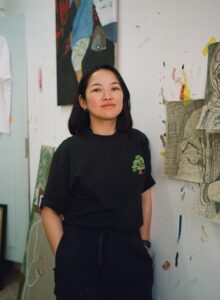
Pris Roos, photo Arno Stevens
With this Open Studio in the first exhibition space, the Rembrandt House Museum returns to its core: an artist’s house where (both 400 years ago and now) new and innovative art is made. During the duration of the exhibition, visitors will have the opportunity to see a contemporary artist at work, and to talk about the topic of ‘feeling at home’.
The exhibition THUIS. The feeling of home in contemporary art is on view in the Rembrandt House Museum from 26 September 2025 to 4 January 2026. Keep an eye on this page for the latest updates and activities.
The exhibition is made possible thanks to the support of the Mondriaan Fund and the Zabawas Foundation.
Rembrandt & Amsterdam
Discover the city through Rembrandt’s eyes in the new summer exhibition
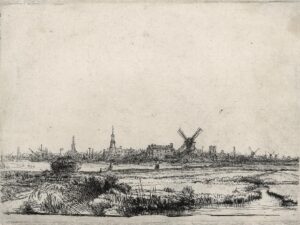
Rembrandt, View of Amsterdam, c. 1640-1641
This year, Amsterdam celebrates its 750 anniversary. The city has much to offer, for residents and visitors alike. That was also the case in the old days. Look at Amsterdam through Rembrandt’s eyes and discover what had already made the city unique 400 years ago. Admire old buildings, unusual places and beautiful surroundings. Enjoy the art, culture and entertainment. Meet interesting people. Spot well-known Amsterdam residents. And find out whether the city already had a red light district in the seventeenth century.
You can see it all in this exhibition containing 60 prints and drawings from the collection of the Rembrandt House Museum. Visit the exhibition through September 7, 2025.
Some highlights
Rembrandt moved to Amsterdam around the age of 25 and lived here for the rest of his life. In and around the city he found everything he needed: from beautiful buildings, entertainment and culture in the city centre to walks in nature outside the city walls. He recorded his impressions in his prints and drawings. Some highlights from the exhibition:
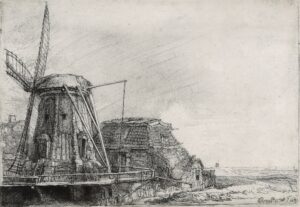
Rembrandt, The Windmill, 1641
Little Stink Mill
Amsterdam has those special places where people like to go. A beautiful viewpoint or a striking monument, for example. This mill stood on the rampart of the city wall, at the end of the Looiersgracht. It was a beautiful high location for looking out over the meadows. On the right in the distance, on the next rampart, stand two people who are also enjoying the view. But as the son of a miller, it must have also been the mill itself that attracted Rembrandt’s attention. However, this spot was not always pleasant. Leather was treated with cod-liver oil in this mill. Hence the nickname ‘Kleine Stinkmolen’ – Little Stink Mill.
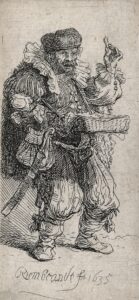
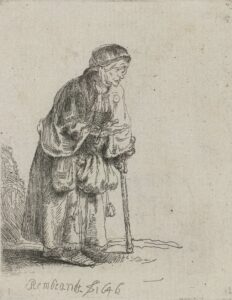
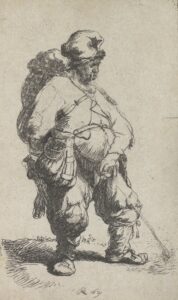
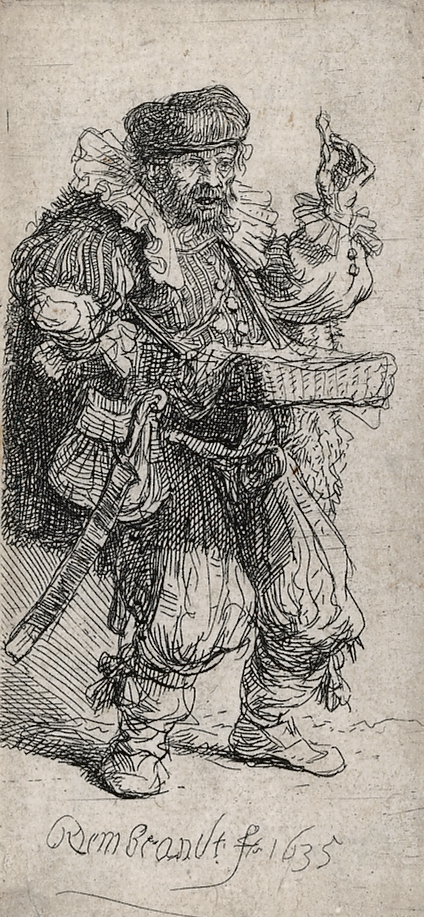
Left: Rembrandt, The Quacksalver, 1635 | Middle: Rembrandt, Beggar Woman Leaning on a Stick, 1646 | Right: Rembrandt, ‘The Pissing Man’, 1630
People Watching
At first glance the man on the etching on the left looks like a pedlar: someone who sells all kinds of useful stuff in the street. But his extravagant clothes, including his codpiece, tell us that he is a ‘quacksalver’: a hustler who sells fake medicines. If you walked along the streets in seventeenth-century Amsterdam you would have met all kinds of people. On one street corner you might be asked for alms, on the next one you might shake hands with an intellectual. On the way you might run into a drunkard and an expat. Exactly like today. The ideal city for Rembrandt, who found all of those different people fascinating.
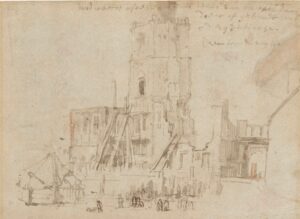
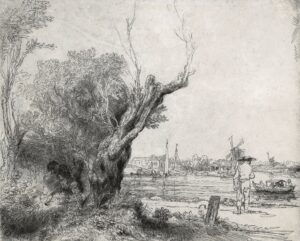
Left: Rembrandt, Ruins of the Old Town Hall in Amsterdam, 1652 | Right: Rembrandt, The Omval, 1645
The Old Town Hall
On the drawing (left) you can see the ruins of Amsterdam’s medieval town hall on the Dam. In the early Sunday morning of 7 July 1652 it was destroyed by fire. The plumes of smoke could be seen from far away. Many artists recorded the destruction. Rembrandt did too. Remarkably enough he subsequently had no interest in the gigantic, new town hall (now the Royal Palace in Dam Square). He never depicted that building.
Walks Outside the City Walls
Rembrandt often walked out of the city along the Amstel. Where the river makes a sharp bend, there is a spit of land which is still called De Omval. There are flats there now, but in the past you could easily spot birds; there were starlings, ducks, herons, wood pigeons and skylarks. In this etching you can spot a very different kind of pastime. Just look into the bushes: there’s a courting couple.
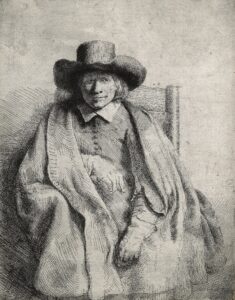
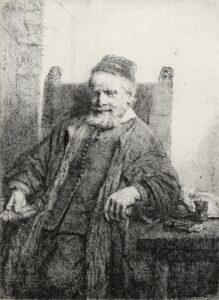
Left: Rembrandt, Jan Lutma, 1656 | Right: Rembrandt, Clement de Jonghe, 1651
Famous Amsterdammers
A big city naturally also has famous residents. They add glamour to city life. Rembrandt knew many famous Amsterdammers, because he had made portraits of them. For instance, Johannes (Jan) Lutma, here on the left; he was a silversmith, the best in town. Rembrandt portrayed him as a monarch on his stately throne. Another famous Amsterdammer was Clement de Jonghe (here on the right). He was a well-known seller of prints in Kalverstraat. If you wanted to buy a Rembrandt etching in the seventeenth century, you could go to him.
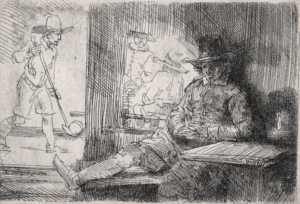
Rembrandt, The Ringball Player, 1654
Entertainment
Amsterdammers loved playing sports. Ball games were particularly popular. The man on the left is playing beugelen, a form of croquet. A ball has to be hit through a ring with a wooden shovel (a ‘sleger’). Beugel alleys were usually located near taverns. The man on the right is sitting indoors and he has already started ‘the third half’’. Entertainment is perhaps one of Amsterdam’s main attractions today – from cinemas and casinos to canal boats and football stadiums. They couldn’t match what’s on offer now in the seventeenth century, but there was plenty to do even then. You could go to the theatre in the Schouwburg twice a week, or visit one of the many inns, drinking establishments and gambling houses, where music was also played.
Book: Rembrandt & Amsterdam
The exhibition is accompanied by a beautifully designed book, featuring all the prints and drawings on display, and the stories behind them. It is available in the museum shop for €9.95. This publication is the third part in a series about Rembrandt’s prints from the collection of the Rembrandt House Museum. The previous publications ‘Rembrandt & Love’ and ‘Rembrandt & the World’ are available separately. This series was made possible thanks to the generous support of the Zadelhoff Cultuurfonds.
Do it yourself
Draw like Rembrandt
In our drawing studio (on the third floor of the exhibition wing), you can make a drawing just like Rembrandt did. Rembrandt often went outside to draw. He made drawings in the city and in the surroundings of Amsterdam. He sketched landscapes and people, but sometimes also buildings that he found beautiful. In 1654, Rembrandt drew the Montelbaantoren, directly across from his house. Try it yourself in a few simple steps. Drawing tables, drawing materials, and an easy instruction are all set up for you. This activity is free, always available, and suitable for everyone from 6 years old.
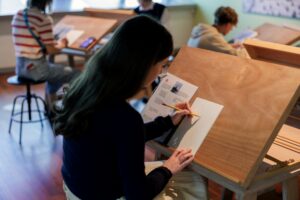
Etch like Rembrandt
Step into Rembrandt’s footsteps during our workshops ‘Etching at Rembrandt’s home’. From July 12th through August 24th, you can add your own twist to an Amsterdam etching from the exhibition by experimenting with the drypoint technique! On a large etching press, you will print two prints, which you can take home afterwards. Click here for more information on this workshop
Cruise with Rembrandt
See the city from the water, just like in the 17th century. This atmospheric canal cruise takes you past locations connected to Rembrandt’s life and his contemporaries. Book the Rembrandt cruise here.
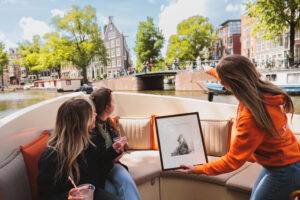
Walk with Rembrandt
Wander through the historic streets where Rembrandt lived and worked. Discover hidden spots, personal stories, and iconic locations that shaped his life. Click here for the free walking tour.

The Illusionist. Samuel van Hoogstraten
Samuel van Hoogstraten (1627-1678), a name to remember. He learned and worked with Rembrandt, in the pupils’ studio of the Rembrandt House. Of all Rembrandt’s students, he became the most successful. During his lifetime, that is. Because, after the 17th century, he was forgotten by the general public, despite the fact that he was a learned artist who constantly experimented with different subjects and optical tricks. He was a pioneer of illusionism: the 3D artist of his time. Later in life, he wrote a famous book full of instruction for new generations of painters. This was his intellectual masterpiece. High time or a renewed introduction.
In this exhibition you will get to know Samuel van Hoogstraten, discover the art of illusion and get to try it out yourself: see past the trickery and create your own optical illusion.
⚫⚫⚫⚫ – Trouw
The Rembrandthuis in Amsterdam shows what painting is capable of illusionism with paintings and drawings by Samuel van Hoogstraten. – NRC
Universal artist
Like his master, Rembrandt, Van Hoogstraten believed that, as a painter, you ought to be able to depict everything. He liked to move between still life, architectural views, scenes from daily life, portraits, and biblical or mythological depictions. There is one subject, however, that is primarily associated with Van Hoogstraten: optical illusion. He was a true pioneer of the painting of trompe l’oeil still lifes, with which he achieved his greatest (international) successes.
Most famous illusion
A highlight of the exhibition is Van Hoogstraten’s Old Man in a Window from 1653. His most famous painting, and an amusing eye deceiver. An old man in life size sticks his head out of a window. Van Hoogstraten precisely rendered all the various materials. Everything looks real. He placed a feather and a slender leaf on the windowsill, on the edge between the painted world and the real one. As if he meant to challenge the viewer to pick them up. Even the monogram and date are part of the visual deception: the text ‘SvH 1653’ appears to have been carved into the bottom right-hand corner of the window frame.
Letter boards
Van Hoogstraten’s letter boards were groundbreaking. He even fooled the Viennese emperor, who reached out to grab an object from one of Van Hoogstraten’s painted letter boards. The items on Van Hoogstraten’s letter boards look like they were brought together by chance. But often they had a very personal meaning for the artist. Therefor a letter board by Van Hoogstraten can be considered a self-portrait as well.
From Vienna to Amsterdam
The exhibition about Samuel van Hoogstraten is part of a diptych, in collaboration with the Kunsthistorisches Museum in Vienna. After his success in the Viennese exhibition, Samuel van Hoogstraten travels to Amsterdam. In the Rembrandt House Museum, many special works of art from foreign collections will be on display in the Netherlands for the first time.
With thanks to: Bader Philanthropies, De Turing Foundation en Het Cultuurfonds, Fonds 21, Mastercard, De Rijksdienst voor het Cultureel Erfgoed, Blockbusterfonds, De Huysgenoten, Vrienden van Museum Rembrandthuis, Amsterdams Fonds voor de Kunst en Kikkoman.
Experimentation
All the artists you will encounter in the exhibition Experimentation – from the 17th century to now – have one thing in common, they experimented without holding back. By trying out different techniques and materials, they continually discovered something new. And they approached the same theme over and over with a fresh perspective. Thanks to these experiments, they developed their craftsmanship into mastery. Discover artworks from the Rembrandt House Museum collection by Rembrandt, Geertruydt Roghman, Glenn Brown, Erik Desmazières, Gérard de Palézieux, Reinder Homan and Willem den Ouden, amongst many others.
In this exhibition you’ll also have the opportunity to make a drawing yourself, right in the middle of the gallery! Try out different types of paper and drawing materials. Just like the artists around you – each and every one of them a source of inspiration.
Experimenting with trees
If Rembrandt were to have a motto, it would have been ‘work from life’. In other words: observe your subject very carefully. This way he was able to very convincingly depict a group of lonely trees on a hill. You can almost hear the approaching wind rustling through the leaves. But Rembrandt was certainly not the only one with strong observation skills. In this exhibition you will see prints by artists from the 17th to the 20th century, who all put their own spin on the same subject. Every print includes a tree, yet it is never the same.
Experimenting with Rembrandt
Tronies were very popular in the 17th century. They are portraits of models that portray a specific type or an emotion. Rembrandt was a master at making tronies. Contemporary artist Glenn Brown (1966) took Rembrandt’s tronies as the basis for his own series. On his iPad he transformed Rembrandt’s artworks into a wild interplay of lines. He then made an etching of the new tronie. Finally, he superimposed two etchings and made the prints that are shown in this exhibition.
Experimenting with the art room
Erik Desmazières (1948) is fascinated by spaces that house collections, like libraries and wunderkammers. In 2007 he visited the Rembrandt House Museum to study Rembrandt’s art room. He made a series of prints based on it. It’s the same arrangement every time, but with some subtle changes. He printed the copper plate several times, adjusting the image slightly between each printing. Sometimes he added more shadows, sometimes some objects. He also experimented with various types of paper.
Experimenting with lines
Willem den Ouden (1928) has lived on the Waal River and studied the landscape for over fifty years. He looks at how he can capture the atmosphere of the river. With just a few lines he depicted the flowing water, the reflections of clouds and low-hanging mist. He prints his lithographs on thin Chinese paper that is glued to a sturdy sheet of paper. There is a French term for this: chine collé. This technique causes the paper to protrude slightly, creating a shimmering effect.
Etched Denim
Invited by the Rembrandt House Museum, another famous Amsterdam creative brand steps into the footsteps of Rembrandt. Following the immense success of the temporary tattoo workshop by Schiffmacher & Veldhoen in 2023, fashion brand G-STAR is innovatively translating Rembrandt’s craftsmanship into Denim. Inspired by Rembrandt’s etching technique and his iconic self-portrait from the museum collection, the G-STAR design team has combined the latest laser technologies with experiments on various types of Denim. This is G-STAR’s tribute to ancient craftsmanship in a modern way.
Rembrandt was not only a great painter, he was also a phenomenal etcher. For example, he not only printed his prints on regular paper, but also experimented with other materials, such as parchment and Japanese paper. This was the reason for G-STAR to give a modern interpretation to his innovative way of experimenting. The designers chose Rembrandt’s self-portrait from 1639 as a basis and investigated with the latest laser technology which types of denim, washings and coatings yielded the best results. In addition, the artworks were adjusted a little bit. Sometimes with the help of AI. The Etched Denim exhibition shows some of Rembrandt’s famous prints and also shows the research into the denim collection.
At the same time as the exhibition, G-STAR is launching a capsule collection. It consists of two denim jackets, two jeans, a shirt and a parka. The unisex collection is available from 31 October in selected G-STAR stores and on g-star.com.
ETCHING ON DENIM
Family workshop
During the Christmas holidays, you can print your own etching on denim. Get started with Rembrandt’s etching technique and discover how you can print your own drawing on denim.
These family workshops are organized daily during the Christmas holidays (closed on Christmas Day), costs €7.50, museum entrance not included. Suitable for everyone from 8 years and up. With a Stadspas, the workshop and museum entrance are free. Maximum 15 participants.
Book your tickets here: Museum Rembrandthuis – online tickets
Rembrandt Open Studio 2024
Rembrandt Open Studio
This autumn, you can meet two contemporary artists at the Rembrandt House Museum! For two months, from 5. October until 1. December 2024, Rens Krikhaar (1982) and Neda Mirhosseini (1995) will set up their studios in one of the museum galleries and create their art, live. As early as the seventeenth century, Rembrandt’s house was a creative hub. A place where Rembrandt and his pupils made art every day. Now, 400 years later, we are bringing back this practice with Rembrandt Open Studio. Each autumn, a new generation of artists is invited to create new work at Rembrandt’s home.
Krikhaar and Mirhosseini share Rembrandt’s rich imagination. Also, like Rembrandt, both artists have a penchant for working on paper. Mirhosseini creates portraits of friends and captures their shared moments in still lifes of tables that have not yet been cleared. These drawings allow her to make any place that’s new to her familiar, and tell stories about her own life. Krikhaar, on the other hand, seeks out the unknown in his artworks. In his drawings and graphic work, we follow a seventeenth-century explorer, who sometimes encounters very unexpected things on their adventures. Krikhaar and Mirhosseini, both in their own way, invite you to explore their paper worlds.
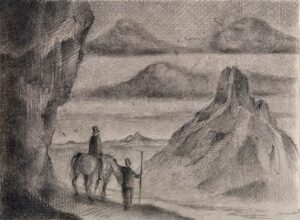
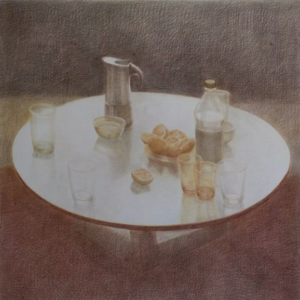
Left: Rens Krikhaar, M’asaaf Riss expedition journal | Right: Neda Mirhosseini, Late Night Early Morning
Rens Krikhaar
The world of Rens Krikhaar (1982) consists of an archipelago with many islands. His work features giant animals, menacing mountainous regions and hallucinatory scenes, ready to be discovered. Krikhaar paints, draws and etches in dramatic light-dark contrasts an ever-growing ‘Terra Incognita’. Man is but a small shadow. Krikhaar: ‘During my working period at the Rembrandt House Museum, I hope to take visitors into my process, and further develop my own work in this special environment.’
Neda Mirhosseini
Neda Mirhosseini (born 1995) documents her daily life through drawings. She shows friendship and intimacy by zooming in on the moments and ways people come together. Portraits of her friends are accompanied by still lifes of tables that have not yet been cleared. The empty wine glasses, coffee mugs, food leftovers, plates and cutlery are the remnants of shared moments, of social connections. According to Mirhosseini, these objects possess a hushed poetry: ‘They are subtle references to the lives that take place behind closed doors.’
Rembrandt Open Studio with Rens Krikhaar and Neda Mirhosseini is on view from 5. October to 1. December 2024 in the Rembrandt House Museum.
Rembrandt & the world
Typically Dutch – that’s how many people see Rembrandt and his work. Unlike many artists of his era, Rembrandt never travelled abroad. But make no mistake. A lot of the world is reflected in his etchings, from lions, exotic shells and turbans, to mountainous landscapes and Italian buildings.
The Rembrandt & the world exhibition will take you on a journey past more than forty of Rembrandt’s etchings from the Rembrandt House Museum collection, etchings that always reveal something that is not typically Dutch. Discover where Rembrandt got his knowledge and inspiration, and how worldly-wise (or unworldly?) he really was.
|
|
Fantasy world
If Rembrandt had a motto, it would have undoubtedly been ‘work from life’. Show what you see: just as it is. Yet he often gave free rein to his imagination. Surprisingly enough, this was also the case with some of his self-portraits.
Stuff
Every 17th-century Amsterdammer knew that the world was bigger than their own neighbourhood. Sea trade was booming business. And through the port, things from all over the world came into the city, some bought, others plundered. Rembrandt enjoyed collecting these new, inspiring things. You regularly see these objects in his etchings.
People
In Amsterdam there was a great diversity of people to be seen on the streets: foreign visitors, international theatre companies, traders passing through and of course immigrants from different countries who had made the city their new home. Rembrandt was often inspired by them.
Clothes
Certain items of clothing and accessories can give a character a little more personality or flair. But Rembrandt could also make many things clear with clothing. What era a scene takes place in, how rich or poor people are, what country or continent they come from and sometimes what their religion is.
Landscapes
High peaks, deep valleys – you see both in Rembrandt’s etchings. But he will never have seen them himself. Mountainous landscapes do not exist in the Netherlands. And unlike many artists of his time, Rembrandt never travelled abroad. He would have had to use his imagination for such etchings.
Buildings
To make stories believable and convincing, the setting must be right. Biblical stories are set in the Middle East. That environment looks different from Rembrandt’s neighbourhood. Rembrandt had to use his imagination for this. Or copy from his more travel-loving fellow artists.
Animals
There are many exotic animals in Rembrandt’s etchings, lions, snakes and elephants. He was able to study some of these in real life, during the annual autumn fair in Amsterdam. For others he had to be creative, not always completely successfully.
In the first room, you can go to work yourself. You will find some exotic shells like Rembrandt has drawn, and drawing materials. And a few practical drawing instructions! Make a drawing of Rembrandt’s shell, or something else that reminds you of the big wide world.
Workshop
In Museum Rembrandthuis you can make your own etching during the summer holidays! In this workshop, give your own twist to an etching from the exhibition Rembrandt & the world. The museum teacher will teach you how you can easily recreate Rembrandt’s etchings with, for example, shells, lions, or his own self-portrait with turban and sword. Experiment with Rembrandt’s drypoint technique and print two prints on the large etching press. You can take these home afterwards. Book your tickets here
Rembrandt of the Neighbourhood
In October 2023, we launched the ‘Rembrandt of the neighbourhood’ project. Young Amsterdammers aged between 16 and 24 learned more about and from Rembrandt and Sumibu, at three locations in Amsterdam: districts Noord, Zuidoost and Nieuw-West. This was reflected in self-made etchings and then T-shirt designs. Each design has its own personal story. All etching designs hang in the museum’s Open Studio until 4 February. Georgy Dendoe, founder Sumibu, chose a winner from each district of the city – their etchings have been given an extra-large frame and can only be bought as T-shirt designs in the Museum shop. Proceeds from the T-Shirts will go towards the next edition of this project.
Directed by: Rembrandt
Rembrandt as director in the spotlights
|
Rembrandt was a master storyteller, not with words but with images. To tell stories, he made use of techniques that were also used in the theatre, such as facial expressions, gestures, lighting, costumes, and accessories. In addition, he chose the best moment to depict: the moment of greatest tension, of ultimate suspense. The exhibition Directed by: Rembrandt highlights, for the first time, Rembrandt’s role as a director of his own artworks. And it reveals how 17th-century painters and theatre-makers were inspired by each other. |
A number of masterpieces are coming to Museum Rembrandthuis for the exhibition, from the Staatliche Museen zu Berlin, Mauritshuis and The Kremer Collection, among others.
Seven Directing Techniques |
 |
|
Just like theatre directors, Rembrandt manipulated all elements in his artworks at his discretion, aiming to depict a story as captivatingly and convincingly as possible. The main directing techniques he used are:
A painter can use the expression on a figure’s face to tell an important part of a story. For this, Rembrandt studied actors in the theatre. He also acted himself in front of the mirror in his studio. |
The Scandal |
|
The biblical character Susanna is about to take a bath. Two important men, elders, spy on her from the bushes. They whisper that they want to have sex with her. Susanna is startled. Rembrandt shows the ‘peripety’ of the moment: the turning point in the story is represented by Susanna turning away. Her eyes meet ours, and through that gaze, Rembrandt involves us in her predicament. The directing here is masterful because it does not get much more uncomfortable than this.
Terrible lie |
|
|
This painting is about a terrible lie. On the right is Potiphar, a courtier to the pharaoh. He listens to his wife telling him that she was almost raped by Joseph. In reality, however, she herself accosted him. The shock on the face of Joseph–on the left–speaks volumes. In the Bible story, Joseph is not featured in this scene, but Rembrandt, as director of his own story, added him to clarify that a great injustice is being done. This painting was created by Rembrandt in the Rembrandt House and is returning for the first time to the place where it was made almost 400 years ago. |
The Perfect Turban |
|
|
According to several of Rembrandt’s pupils, he could spend two days winding a turban. Apparently, he took time to assemble various parts of a costume before beginning to paint or draw them. He probably took similar care to prepare this study of an old man. Rembrandt made this study in preparation for depicting the high priests in his painting Judas Repentant (1629). He wanted to know exactly how the light falls on the back of the head of a man wearing a turban. |
Four stories, One image |
|
|
Usually, artworks depict a single moment, a single scene. This is the same in theatre, where the unity of time, place, and action is a golden rule. But, in this etching, Rembrandt brought together four moments from a single Bible story as if they had taken place at the same time. Like a director, he placed his figures in a well-balanced troep (group), alternated their height (sprong), and added plenty of verscheydenheydt (variety). The image is also full of drama and reminds us of the tableaux vivants that were popular in the Schouwburg theatre. |
Exhibition at the Stadsarchief Amsterdam
Concurrently with the exhibition Regie: Rembrandt, the Stadsarchief Amsterdam is organising a treasury exhibition highlighting the broader context of the Amsterdam Schouwburg, its playwrights and actors, and its role in the city.
The exhibition Directed by: Rembrandt will take place from 2 March to 26 May 2024 at Museum Rembrandthuis.
|
With thanks to: Mastercard, het Cultuurfonds, Rijksdienst voor het Cultureel Erfgoed, Huysgenoten van Museum Rembrandthuis, Kikkoman, Blockbusterfonds: Extra, Vrienden van Museum het Rembrandthuis, De Gijselaar-Hintzenfonds. |





